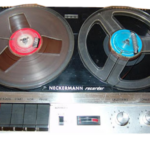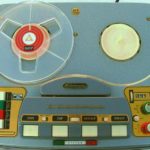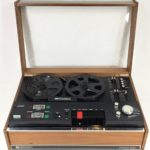In order to use this feature, you need register and become a member.
Already a member? Login Register hereNeckermann Reel to Reel Tape Recorders

1948 To 2012
Company Description Submit New Info
Neckermann produced reel to reel tape recorders which were manufactured in Germany. These tape recorders targeted the consumer market. The early models of Neckermann tape recorders used tube electronics and later on they transitioned to solid-state tape recorders. The company produced both 2 and 4 track machines available in 220-240v voltages.
Neckermann, a large mail order company, cut a deal with Korting in 1954 for them to supply all their radios, tape recorders and TV production exclusively to the Neckermann group. Körting product would no longer be for available in Germany but they were free to sell their product for export. The specifics of the tape recorder arrangement we do not know as of yet, but a number of tape recorders would be produced over many years branded with the Neckermann name and of course, built by Körting. This arrangement seemed quite unusual so we decided to investigate further and find out what N was about. It turned out to be an interesting story that has an entrepreneur who became an equestrian gold medalist and had a checkered past.
Josef Neckermann (1912-1992) was asked to take over his father’s very successful coal business in 1931 in Würzburg at the age of 16. His father died the same day. In mid-1930s Germany Aryanization of Jewish businesses had begun and the 20 year old Josef made his first acquisition in 1935, a textile store in Würzburg owned by Siegmund Ruschkeewitz. He was forced to sell his store at 10% of its value to Neckermann. Shortly thereafter Neckermann brought a Nazi member to the store and together they threw Ruschkewitz out. A second bargain-basement purchase followed with Merkur – 130 Employees and 60 sales reps. It was a good time to buy businesses at well below market value and a department store followed, also in Würzburg, the Vetter department store that had previously been Aryanized by the owner. A a new law was passed in June 1938, forfeiting all Jewish businesses to Aryan ownership. Neckermann now targeted the fourth largest textile mail order company in Germany, located in Nuremberg and founded by Karl Amson Joel, grandfather of pianist/singer Billy Joel.
Certain suppliers had began cutting Joels supply off and an unwelcome German plant manager had been installed. The company was now ordered to stamp all outgoing packages with a “J”. Karl Joel reluctantly sold his company to Josef Neckermann for some 2.3 million Reichsmarks (equivalent to 1/2 Million US dollars today) at less than a fifth of its real value. Joel was forbidden to use his own attorney. When he asked for some assurance that the agreed-upon sum would be paid, he was answered with ominous threats that he would be wiser to look after his own security. Neckerman also took possession of the Joel family house.
The original agreement of 2.3 million marks was later reduced by Neckermann to 1.1 million marks. Before the transaction was completed, Karl Joel fled to Switzerland unpaid and it would be until 1957 before reparation paid him a well under market value settlement at 2 million DM.
With war imminent, Josef Neckermann began looking for government contract opportunities, a prudent decision. Neckermann secured a contract with Fritz Todt, the General Inspector for Construction and supplied blankets and work clothes for the 100,000 workers from 1938 forward. Neckermann was a man of contacts and got close to the textile manufacturer Hans Kehrl , who was to become the economic representative of the Führer and Reich Chancellor from 1934. Neckermann founded the Central Warehouse Association for Clothing (ZLG) at the end of 1941 with Georg Karg, who had also founded his department store in the 1930s through aryanization. ZLG, became a monopoly as Neckermann knew another man of influence, Otto Ohlendorf who he made a silent partner in ZLG and now they were getting inside information on raw materials and transportation. ZLG was supposed to supply all the textile manufacturers fairly with orders but Neckermann was in control and gave his companies preferential treatment.
Another high point in his career was when Albert Speer was appointed Reich Minister for Armaments and Ammunition in early 1942. Neckermann was now designing winter uniforms for the Wehrmacht and on Speers suggestion, presented his collection to Hitler on his 53rd birthday at the Fuehrer’s headquarters in Wolfsschanze. The uniforms were approved and Neckermann produced 2.5 million units for the upcoming winter on the Eastern Front. Eventually Neckermann became the head of the Reich Office for Clothing.
As the second world war came to a close, most of the Neckermann factories had been damaged by bombing with the exception of the Vetter fashion house.
Companies that had been taken over by Aryanization were now in the trusteeship of the Allied Control Council, based on a law passed in August 1945 and the owners were not allowed to resume business or access their properties. In spite of that, Neckermann attempted to re-start his business in Würzburg and to bring two companies of the former ZLG under his control. Things didn’t work out and he was sentenced by a military court in December 1945 to one year in a labor camp for violating the Control Council Act.
Neckermann KG was founded in Frankfurt September, 1948 and now it was time to plan his reentry back into the business world. There was a pent-up demand for consumer goods in the early 1950s and mail-order businesses were rampant with approximately 4000 in existence at the time. Undeterred, when Josef had 450,000 DM. freed up by the Allies from his Würzburg business, it was time to enter the mail-order business.
The first 12 page Neckermann catalog of March 1950, featured 133 inexpensive textile articles and 100,000 were printed. He managed to sell 10 million DM in his first year. By 1953 the catalogue included furniture, leather goods, lamps and radios. Refrigerators,televisions and electronic items including tape recorders were added the next year.
Retailers that sold appliances and electronic devices were now feeling threatened by mail-order and in February 1954, the electrical guild circulated a request to all retailers to refuse to install or repair Neckermann products. The company had been private labelling manufacturers devices and very often sold the same product for 40% less with a new logo, “N” Neckermann took them to court but lost and was forced to set up a service network with 250 mobile technicians and 200 drop-off points. Electrical appliance sales continued to improve.
The catalogue was now 300 pages and released twice a year with a circulation of 2.5 million.
In 1956, they branched out into sales outlets or department stores with the flagship location in Frankfurt.
Neckermann had begun with 107 employees in 1950 and by 1958 there were over 6,000. Neckermann Versand and Quelle Schickedanz (Gustav Schickedanz)dominated mail order in the 1950s.
In 1965, 3,811 people worked in the Frankfurt dispatch center, and a further 14,297 people were employed in the textile factories in Frankfurt, Darmstadt and Essen. Overall, the Neckermann Group generated more than DM 1 billion for the first time this year.
More cheap discounters arrived in the German market in the 1960s and in spite of the fact the Neckermann Group’s sales had grown over two decades, the company was in the red as the margin became too low. Big turnover with small profit was turning out to be a bad recipe. Even as early as 1963, the company’s liabilities were increasing and the banks threatened to stop financing, so Josef put together an IPO. Sales volume continued to increase through the 60s and into the 70s but by 1975 the company was on the verge of bankruptcy. The 1973 oil crisis caused many well-established companies file for bankruptcy, with the demand for consumer goods falling off significantly. Neckermann changed his strategy by increasing prices in the autumn / winter catalogue of 1974 and customers started buying more from the competition, so that plan was discontinued. 1975 marked the companies 25th anniversary they offered 10% off everything in the spring/summer catalogue. Sales grew from 2.9 billion to 3.5 billion DM in 1975, however the mail-order company posted a loss of around 4 million DM.
In the spring 1976, Josef started to negotiate a potential merger with his competition, Walter Deuss of Karstadt and by July it was announced that Karstadt would become a major shareholder in the company. The losses continued through 1976 with a deficit of 7.7 million DM.
The last shareholders’ meeting of Neckermann Versand took place on June 1, 1977, after which Karstadt AG became the new owner.
Josef Neckermann was moved to a post on the supervisory board of the new company for a year and then retired. He then devoted himself exclusively to his “second life’s work”, Deutsche Sporthilfe. His son Peter left the company and Johannes Neckermann was the last to leave in August 1978. Both sons emigrated to the USA in 1980 and 1981.
Josef Neckermann was a German equestrian and Olympic champion. He won Olympic medals at four different Olympics, in 1960, 1964, 1968 and 1972. Later Neckermann became a member of the West German National Olympic Committee.
A Documentary called The Joel Files was made about Billy Joel’s family and their struggles to survive— and escape—the rise of the Nazis in Germany.



